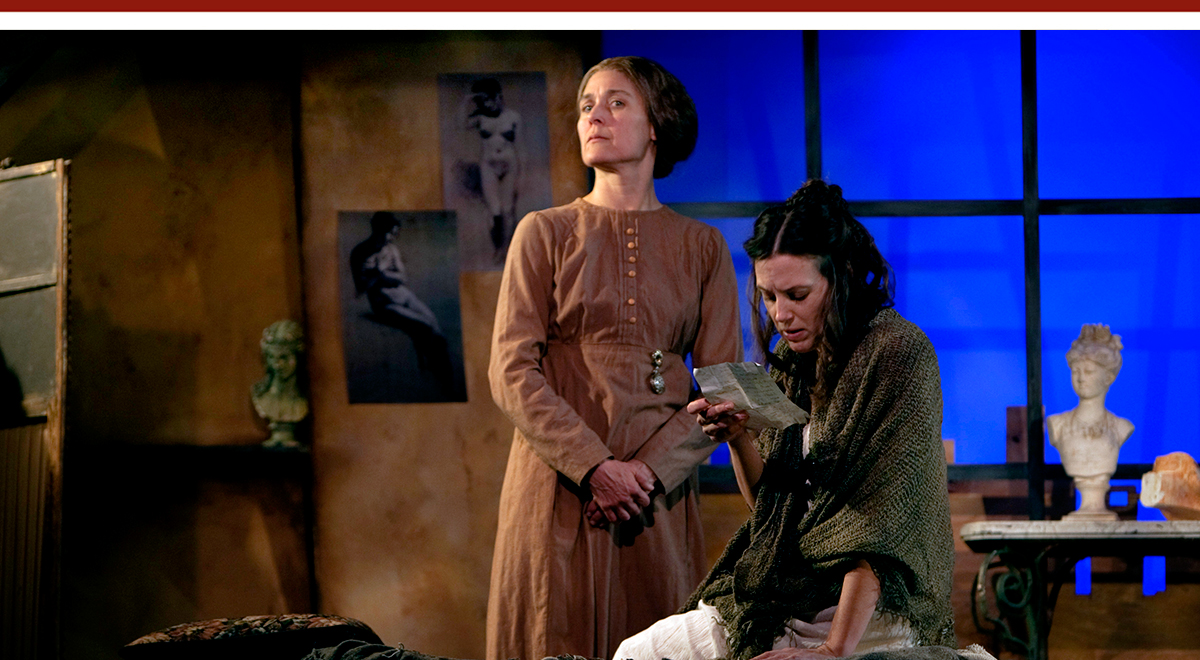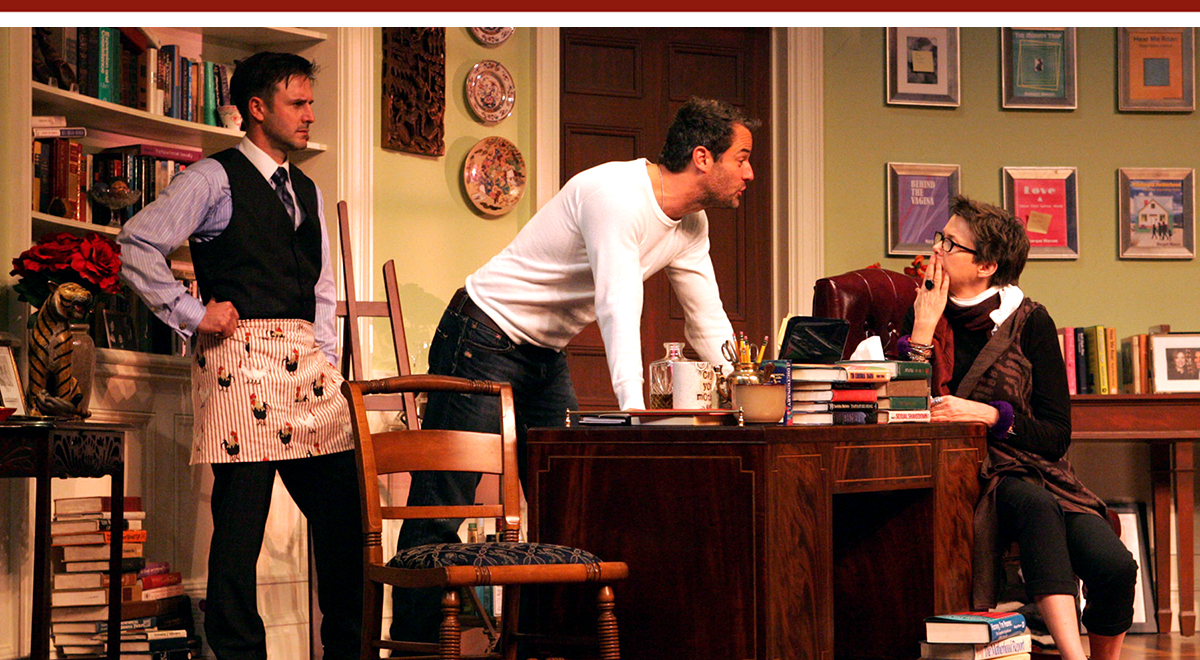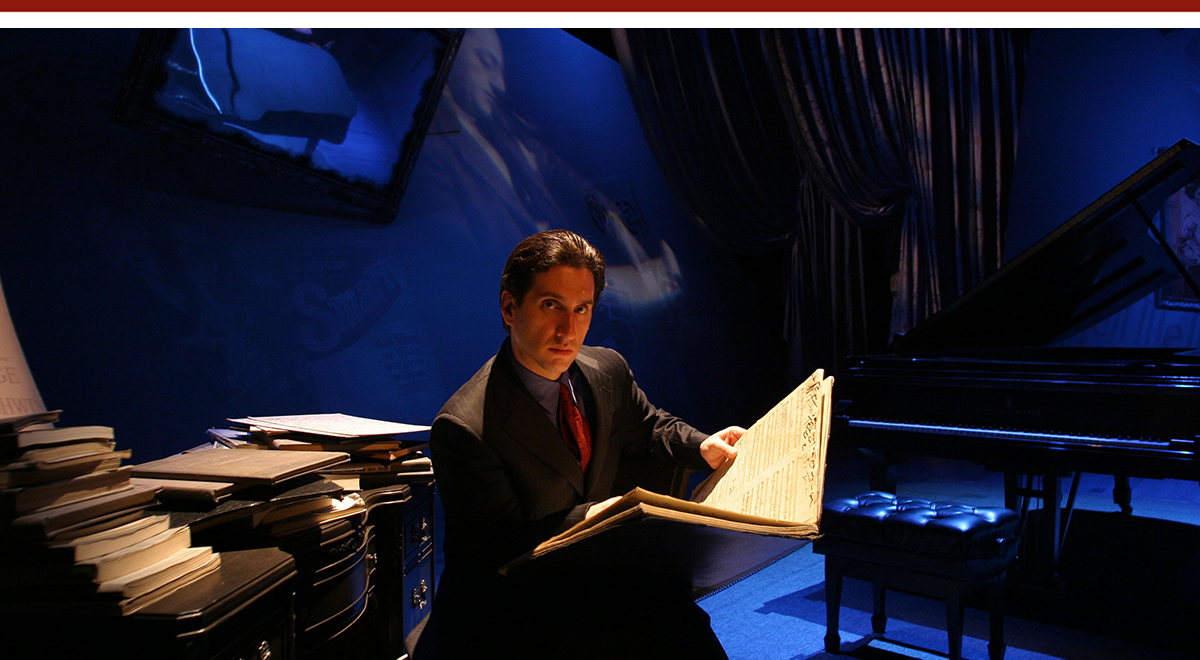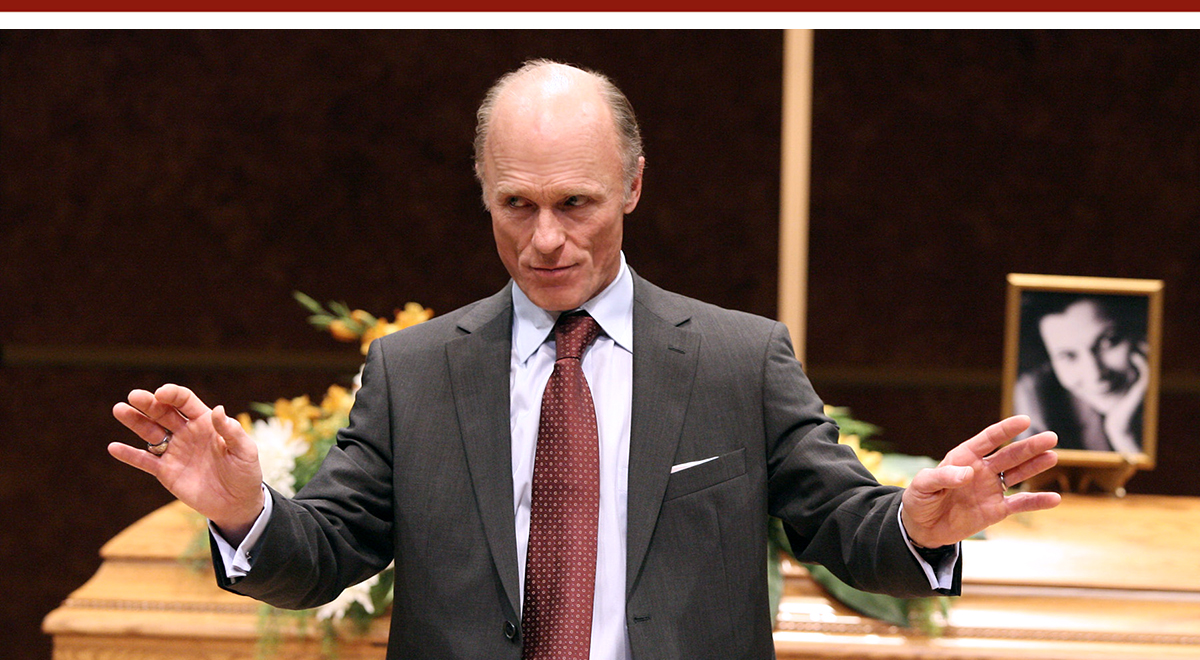FEBRUARY 2010
Click title to jump to review
COUSIN BETTE by adapted by Jeffrey Hatcher | Antaeus Theatre Company
THE FEMALE OF THE SPECIES by Joanna Murray-Smith | Geffen Playhouse
GEORGE GERSHWIN ALONE by George & Ira Gershwin and Hershey Felder | Laguna Playhouse
MERRILY WE ROLL ALONG by Stephen Sondheim and George Furth | Chance Theatre Company
WRECKS by Neil LaBute | Geffen Playhouse

Our American ‘Cousin’
From the first words of his 1846 novel – its title – Honore de Balzac distanced Cousin Bette. By labeling her 'cousin' he aligned readers with her rich relations and assigned her relatively less importance. Now Playwright Jeffrey Hatcher adds his perspective to the oft-adapted work, in a version premiering at the Antaeus Company in North Hollywood, under the direction of Artistic Director Jeanie Hackett.
Hatcher’s challenge in wrestling Balzac’s sprawling work to the stage is to tell the story with enough dressing to honor the epic novel but not get mired by redundant detail. For her part, Hackett must find the tone to tie it all together.
The first thing Hatcher does is make Bette the narrator. This wisely lets audiences see events through her eyes. It also creates a new challenge for the writer. As narrator, Bette must recount her elaborate revenge while slowly revealing things she doesn't realize about herself. The same blinding hatred that fuels her machinations also fogs her perceptions, and will be her ultimate undoing. It’s a rich role for an actress, and Anteaus has within its company two of the region's more accomplished women – Alicia Wollerton (reviewed here) and Nike Doukas – to alternate leading this three-hour, two-intermission adaptation.
Nevertheless, there is sprawl to this narrative, and Hatcher and Hackett are ultimately unable to control it. For the writer, extended plot intricacies, while appropriate for readers centuries ago, test even the dominant presence of Ms. Wollerton. Nevertheless, while one feels the script could be honed down for greater effect, there is a substantial amount of solid storytelling and intrigue for audiences to enjoy.
Hatcher's American Cousin begins beautifully. Wollerton emerges out of a crowd, a voice of perspective on a stage of fools. The “poor relation,” as she mockingly labels herself. There is a lot of plot to spin before we discover whether or not Bette is vindicated, or submerges back within the world of privilege. We know from Wollerton’s act one narrative that she feels estranged, as much from the properties of love and affection as from the family’s properties. The most important asset she has at the beginning is hope. which comes from her belief that the winds of fate are at the back of victims of injustice. Her initial lack of love and security is only tolerable as long as there is hope that these needs will be fulfilled. That hope allows her to open her heart to Steinboch (Daniel Bess), a handsome artist. Family and friends and foils will be embroiled as victims and accomplices along the way as Bette works her plan against those she feels have wronged her.
For Hackett, making the long-winded narrative both entertaining and true produces some disparity of acting styles. In this case, the Antaeus company's double-casting and scrambled schedules – rarely an issue with this finest of L.A. acting companies – keeps a single onstage ensemble from coalescing. While it’s no problem for the audience, and the principle actors are first-rate veterans, there is still the added challenge of playing to members of a revolving ensemble. And that seems to have further fragmented the styles. While Robert Prosky, for example, is delightfully farcical, it seems to be from a different play. Woolerton keeps her Bette solidly earnest, but in the final moments seems to sway towards the comic.
There’s not a lot designer Tom Buderwitz can do to shoehorn a 19th Century world into the storefront Deaf West Theatre space, and so he is restrained, creating a simple two-tier set with minimal dressing. A. Jeffrey Schoenberg adds richness in the costumes, and Leigh Allen and Cricket S. Myers provide layers of light and sound, respectively. Sarah Hatten’s hair treatments are also well served.
top of page
COUSIN BETTE
by JEFFREY HATCHER
based on the novel by HONORE DE BALZAC
directed by JEANIE HACKETT
ANTAEUS THEATER COMPANY
February 6-March 21, 2010
(OPENING, REV’D 2/26)
CAST (reviewed) Daniel Bess, Cylan Brown, Dana Green, Katherine Leigh, Micheal McShane, Mark Moore, Rebecca Mozo, John Prosky, Joseph Ruskin, Adeye Sahran, Jeremy Shouldis, David St. Louis, Laura Wernette, Paul Willson, Alicia Wollerton, Nicol Zanzarella-Giacalone. (alternating) Tony Amendola, Bill Brochtrup, Emily Chase, Jen Dede, Nike Doukas, Paul Eiding, Alexandra Goodman, Henri Lubatti, Aaron Lyons, Jill Maglione, Kellie Matteson, Robert Pine, Janan Raouf, Mirron Willis, Benny Wills
PRODUCTION Tom Buderwitz, set; A. Jeffrey Schoenberg, costumes; Leigh Allen, lights; Cricket S. Myers, sound; Sarah Hatten, wigs/hair; Christopher Breyer, dramaturg
HISTORY World Premiere of Adaptation
Alicia Wollerton and Dana Green
Michele K. Short
Women on the Verge
In The Female of the Species, playwright Joanna Murray-Smith drives her crazed vehicle of a farce headlong into the murky waters of psycho-babbling, pop-culture feminism. Like one honking spit-take, the impact soaks movement prophets and profiteers alike, as well as the men and women who over-heeded the call, and those who completely missed the boat. Somehow, amid the falderol, we get a reminder of the injustices and insensitivities that have been – and still need to be – addressed.
Just as impressive for L.A. theater-watchers is how successfully this over-the-top farce plays. Randall Arney, Artistic Director of the Geffen Playhouse (where it continues through March 14), ramps the energy level up early and gets it to stay there for the 90-minute, intermission-less romp. It is what Murray-Smith’s writing requires, given the unbelievable personalities she’s created. Furthermore, her plot, which hangs on a single threat early on, places the characters in a pressure-cooker that needs to keep boiling or it makes no sense. And, given the singularity of the subject matter, audiences may feel they are hearing ideas and indignities repeated again and again. Occasionally tossing in a meaty new plot point along the way might have added variety.
Annette Bening leads the loonies as Margot Mason, the leading literary figure of the decades-old movement. Her books have consistently generated millions of dollars and millions of followers, who have snatched up new volumes as quickly as she can turn them out. But she needs to get over her writer’s block and turn one out very fast to meet her deadline and help her publisher, Theo (Julian Sands), stay afloat in changing times.
Bening’s opening monologue draws on a writer’s favorite topics – the difficulty of writing, and the unpredictability of public taste. Just when it seems inspiration may be back, a fan, Molly (Merritt Wever), slips in through the French doors wanting to talk. She is followed by Margot’s sad-sack daughter, Tess (Mireille Enos), who is in such a funk that she has left her three young children, wandered into town in her robe, slippers and pajamas, and taken a cab to confront mother. Eventually, her husband, Bryan (David Arquette), following a tip that the motherless children may be having a hard time, arrives to find out what’s wrong.
Next in is Frank (Josh Stamberg), the cab driver who has been waiting in the driveway for 45 minutes, stewing because Tess hadn't listened to him on their drive over. Finally, desperate for something to begin reading, publisher Theo arrives, too. As last to join, Sands has the least stage time, but gets to dish out Murray-Smith's unlikely denouement, which is reminiscent of the ways Wilde pulled his Earnest resolution from a hand-basket and the Wizard of Oz handed his to characters from a balloon-basket. It’s great fun, and there's one more surprise to bring down the curtain.
The set is a beautifully rendered a rotunda writing room by Takeshi Kata. David Kay Mikelsen contributes costumes that help define the personalities, from Margot’s calf-length vest, to Tess’s kid-friendly pink robe and jammies, to Theo’s matching red socks and tie.
Murray-Smith, who premiered this play in London’s West End in 2008, puts plenty of focus on the role of mothers – both as mentors and martyrs. She has given us a play that, after the laughs fade, leaves plenty to chew on.
top of page
THE FEMALE OF THE SPECIES
by JOANNA MURRAY-SMITH
directed by RANDALL ARNEY
GEFFEN PLAYHOUSE
February 2-March 14, 2010
(opened 2/10, rev’d 2/11)
CAST Annette Bening, Merritt Wever, Mireille Enos, David Arquette, Josh Stamberg, Julian Sands
PRODUCTION Takeshi Kata, set; David Kay Mickelsen, costumes; Daniel Ionazzi, lights; Richard Woodbury, music/sound; James T. McDermott/Jennifer Brienen, stage managementHISTORY 2008 West End production earned an Olivier Award nomination for Best New Comedy
David Arquette, Josh Stamberg, Annette Bening
Michael Lamont
Embraceable
Drawing upon solid talent as concert pianist, stage actor and book writer, Hershey Felder has created a trio of unique one-man piano-recital-bio-plays. Beginning with George Gershwin Alone in 1998, his three-composer set spent the past decade winning fans around the world and earned him more appearances at Southern California theaters than a local union rep. Now, he gives his three alter egos their Orange County bows with consecutive runs at the Laguna Playhouse: Gershwin, now through February 21, Frédéric Chopin (in Monsieur Chopin, February 25-March 7); and Ludwig von Beethoven (in Beethoven As I Knew Him, May 11-23).
Of the three, Gershwin Alone has features to gain it the tightest embrace by general theater audiences. Gershwin offers the familiar American immigrant success story, a gone-too-soon ending, and music with one huge advantage over the others. Hundreds of the songs he composed for stage and film musicals have beautiful lyrics by his older brother Ira, a man as respected for his work as George was for his. This means that Felder can cultivate a more intimate living room environment as he sings the Gershwin Brothers classics to the audience treated as guests in his apartment. And, after the 90-minute story ends, with a complete performance of the ground-breaking “Rhapsody in Blue,” Felder breaks character for a 20-minute singalong of requests that he gamely leads, complete with line-by-line prompting. (It may be the one time an elder-leaning matinee audience, who are familiar with all the songs, may prove more energized than the evening.)
The show mixes highlights of Gershwin’s tragically short life and career – he died in 1937 at the age of 38 – and a good sampler of his work. We learn the stories behind the songs, too: from his career-launching "Swanee," to the expansive opera Porgy and Bess – which included the milestones “Summertime,” “It Ain’t Necessarily So,” and “Bess You Is My Woman Now” – to “Rhapsody,” and such musicals as Strike Up the Band, Funny Face and Girl Crazy.
This is not a case of a resourceful actor calling upon modest piano skills to milk a one-man-show gimmick. Felder is a trained musician who first performed “Rhapsody” professionally at the age of 16. My only other experience with his work, the Beethoven piece, felt it sacrificed theatrical intensity for the display of piano virtuosity in numerous sections of Ludwig van's pieces. It was too much concert. As great as Felder is, he lacks the transcendent talent that has drawn us to major halls for Ax, Lupu, the Serkins, et al. However, in Gershwin, we get even more, as the lyrics allow us greater insight into the man and his time. And Felder's interpretations of these classics show him to be a superb vocalist.
His storytelling is also well-crafted. He knows his stuff about George and his intimates – from Kay Swift to Oscar Levant. As the book writer, the pianist and the singer, Felder gracefully combines the best aspects of storytelling, recital and cabaret.
The backdrop for Yael Parnell’s set – presumably the design that travels with the show – features a swoosh of sheet music covers rising like magic carpets from a stack of manuscripts on a stage right desk. Across the stage, flanking the central Steinway, a table, chair and lamp serve as location for some of the narration. Photographs of people, productions, and more sheet music are projected onto a scrim, and two swags of rich drapery add the final touch of the living room intimacy bathed in Michael T. Gilliam’s candle-glow light design.
The story of this important American composer, who embraced the blues scale sounds of African-American music (which he explains in a show-opening "music lesson" about minor thirds), not only provides a chance to hear – and sing – some of the best lyrics and melodies in the American songbook, but to experience the spirit of the composer as a welcoming friend.
top of page
GEORGE GERSHWIN ALONE
music and lyrics by
GEORGE GERSHWIN & IRA GERSHWIN
book by HERSHEY FELDER
directed by JOEL ZWICK
LAGUNA PLAYHOUSE
January 12-February 21, 2010
(opened 1/16, rev’d 1/31m)
CAST Hershey Felder
PRODUCTION Yael Pardess, set; Michael T. Gilliam, lights; Tamora Wilson, additional lighting design; Jon Gottlieb, sound; Gigi Garcia, stage management
HISTORY Originally developed at the Tiffany Theatre, Los Angeles, Produced on Broadway at the Helen Hayes Theatre, Produced in London’s West End at the Duchess Theatre. Orange County Premiere
Hershey Felder
A good thing going
Merrily We Roll Along opened at The Chance Theater (where it continues through March 7) on the same day the most important theatrical partnership in Orange County history announced its expiration date. After 46 years, the team that led South Coast Repertory to national prominence signaled that the end of their road was in sight. By chance, up the freeway in Anaheim the young company that most recalls the more-talent-than-money promise of SCR’s storefront days was opening its 12th season – with the musical that follows a theater team back from national prominence to their days of more-talent-than-money promise.
 In 1981, composer-lyricist Stephen Sondheim and librettist George Furth co-wrote the musical that came between Sondheim’s two most-inspired works – Sweeney Todd and Sunday in the Park with George. It was based on a 1934 George S. Kaufman-Moss Hart play that showed the moral decline of a wealthy playwright by following his life backwards from age 40 through his successive sell-outs and compromises to end with the starry-eyed 20-year-old, ready to change the world through art.
In 1981, composer-lyricist Stephen Sondheim and librettist George Furth co-wrote the musical that came between Sondheim’s two most-inspired works – Sweeney Todd and Sunday in the Park with George. It was based on a 1934 George S. Kaufman-Moss Hart play that showed the moral decline of a wealthy playwright by following his life backwards from age 40 through his successive sell-outs and compromises to end with the starry-eyed 20-year-old, ready to change the world through art.
In the Sondheim-Furth version, we move the play’s starting point to Hollywood in 1976, and move back into the bright days of the mid-‘50s. In Artistic Director Oanh Nguyen’s staging, the lights rise slowly on famous film producer Franklin Shepard (Jeremy Fillinger), in an obvious state of depression, slumped over his piano. As the rest of the ensemble emerges from panels in the sides of Christopher Scott Murillo’s elegantly simple set, carrying the metal chairs that will be the only other stage furniture, they sing the play’s central question: “How does it happen? How did you get so far off the track?”
The next two hours will show what happened, but not why. The answer is embedded in Franklin’s childhood and the American dream, and not really what interested the writers. “I love success,” he says at one point, and that's going to have to suffice. Instead, we follow the puzzle-loving Sondheim’s paradoxical reverse-narrative that shows Shepard acquiring greater character as he grows younger. In the process, he regains the close friends he jettisoned for fame – songwriting partner Charles Kringus (Ryland Dodge) and pal Mary Flynn (Annie Bjorklund). Mary, who quietly carried a torch for Franklin and is now a full-blown alcoholic (Dorothy Parker was Kaufman and Hart’s inspiration), has remained a friend, but is quick to lash out at him for his shallowness. Charlie no longer speaks to him.
In addition to the central trio, the showy roles are Beth (Franklin’s first wife, played by Liz Holt), and Gussie (Franklin’s second wife, played by Laura M. Hathaway). Fillinger is a solid Shepard. All have fine voices and know their characters. Fillinger and Holt have the best handle on singing-acting (finding the dramatic essence without overplaying). Alex Bueno makes the most of several tiny scenes, laying in comic bits that hit the top without going over.
The full cast is onstage for the entire show, watching attentively from their chairs along the sides, stepping in for speaking roles, or joining together as Greek chorus and filling the small, square stage with Kelly Todd’s spare but energetic choreography. The others are Kyle Cooper, Richard Comeau and Andrew Eddins. Katie Schmidt designed costumes that help tell the story: from the black-suited Franklin, to his pals in gray, to the women in black-and-white prints, etc. The clothes look great bathed in blues and purples of KC Wilkerson’s tasteful lighting design, while Murillo’s projections in the top back wall help establish location.
Given a structure that suggests people inevitably sacrifice their ideals for comfort and notoreity, we might be left leaving Merrily with a less-than-merry dose of cynicism. Surely Sondheim’s goal was something more uplifting, and here we get that. As the company ends the show singing “It’s our time, breathe it in,” they effectively turn the inverted story back around to make it current – about them, about us. We leave buoyed by their promise, with the sense of anticipation usually connected with the beginning of a show rather than its end. While this owes a great deal to the Sondheim magic, it’s exciting that Nguyen and company found it in this often misunderstood musical and took their time to share it so well.
top of page
MERRILY WE ROLL ALONG
music and lyrics by STEPHEN SONDHEIM
book by GEORGE FURTH
choreographed by KELLY TODD
musical direction by MIKE WILKINS
directed by OANH NGUYEN
THE CHANCE THEATER
February 4-March 7, 2010
(2/4, 2/14m)
CAST Amie Bjorklund, Alex Bueno, Kyle Cooper, Richard Comeau, Ryland Dodge, Andrew Eddins, Jeremy Fillinger, Laura M. Hathaway, and Liz Holt; u/s Sarah Moreau
MUSICIANS Mike Wilkins, piano; Jonathan Proctor, flute/clarinet/alto sax; Cole Peterson, percussion
PRODUCTION Christopher Scott Murillo, set/projections; Katie Schmidt, costumes; KC Wilkerson, lights; Courtny Greenough, stage management
Jeremy Fillinger, center, with Kyle Cooper, Laura M. Hathaway, Richard Comeau, Ryland Dodge, Andrew Eddins, Amie Bjorklund and Liz Holt
Christopher Trela
A strange and mournful day
When Neil LaBute has his mojo working – as he has in Bash, Autobahn, and Fat Pig – his storytelling leads us willingly down the garden path only to find ourselves left in a very uncomfortable spot. When it isn't working – as was the case with Some Girls(s) – it's just uncomfortable. With Wrecks, a play he directed in Ireland in 2005, New York in 2006, and now at the Geffen (through March 14), he's back expertly paving another twisted tale of good intentions.
For this third mounting of Wrecks he again has Ed Harris to deliver the 80-minute monologue he shared with Irish and Off-Broadway audiences. Anything that would prompt Harris to do eight shows a week for six weeks would be worth the trip. But this is an especially nice match, and in the Geffen's intimate Skirball theater it's a rare treat.
This review will not get close to the revelations that are buried at the end of the hour and 20 minute stroll.
While Labute's unadorned writing has the effect of backing us through the play so that we don't see what's coming, Harris' no-nonsense bearing always seems to be approaching things head on. It's like a writer-performer hook-up conceived on Match.com. His steely self-assurance has given Harris an edge since we first saw it come out midway through Lee Shallat's staging of True West in Costa Mesa nearly 30 years ago. Here, it reinforces his character's deep conviction in the rightness of his beliefs, and that keeps Labute's play right side up, even as audiences exit rattling their heads to sort out what they've seen.
Edward Carr (Harris), who became a widower earlier this week, is taking a moment for himself in the sanctuary where the casket of his late wife, Mary Josephine Delaney Anderson Carr, awaits her memorial. In an adjacent room, we hear the murmurs of his children and stepchildren discussing their situation. Though Carr comes onstage to get away from family, he seems almost relieved to find a theater audience of strangers in whom to confide. He begins telling us his story, mentioning more than once that we are going to hear things that he will not be telling the relatives and friends who live on his side of the fourth wall. It is an engaging device, made all the richer by having the much-admired Harris chatting with us as intimates. The moat between character and audience has disappeared to the point that Harris asked one fidgety gentleman if he'd be more comfortable leaving early. "It's okay," Carr said to the man. "You can go if you want to." (He stayed.)
We will learn a lot about Mr. and Mrs. Carr, about the business they built together, about her first husband and his business, and about her cold-hearted mother. Traditions of parents and children are the underlying concern of Wrecks, resonating as far back as the characters of ancient drama recalled in the homophonic title. Mary Jo – not accidentally a name that evokes the blessed union of Jesus' folks – and Ed lived together in an idyllic state of love, intimacy and sharing.
For more than an hour, Harris’ Carr holds court, smoking unfiltered Camels and carefully filtering the story of his special matrimony. Harris invests completely, even tumbling to the ground in a recreated fight scene. (Which spices things up at the cost of feeling out of place.) He gives the playwright the full emotional portrait – anger, tears, laughter – all the while laying down the bits and breadcrumbs that we will look back on at curtain and use to piece together the whole picture. There is more to the story than we are told explicitly, and enough clues to solve the four-word puzzler Labute leaves us to work on the way home.
If Labute and Harris, both working at the top of their form, weren’t enough, throw in Sibyl Wickensheimer, who never fails to impress. Here, her set is sanctuary-modern, with three upstage walls of brown marble, divided into six squares that, in their seams, reveal illuminated crosses. The center cross alone is lit for most of the show. Another convoluted – and much appreciated – roadsign that suggests we have been gathered not to judge, but to understand and forgive.
top of page
WRECKS
written and directed by NEIL LABUTE
GEFFEN PLAYHOUSE
February 7-March 14, 2010
(opened 2/10, rev’d 2/12)
CAST Ed Harris
PRODUCTION Takeshi Kata, set; David Kay Mickelsen, costumes; Daniel Ionazzi, lights; Richard Woodbury, music/sound; James T. McDermott/Jennifer Brienen, stage managementHISTORY Wrecks is a one-man play by Neil LaBute, that was first staged in Cork, Ireland. The play was a part of the city's Capital of Culture programme in 2005. It made its American debut at the Public Theater (in an extended run) in New York City in 2006. Both productions starred Ed Harris and were directed by LaBute.




